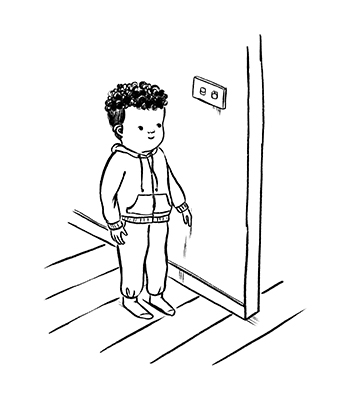Moving the walls: why it’s good for children with disability, autism or other additional needs
Moving the walls is when children press the back of their hand into the wall as hard as they can and then release their hand.
Moving the walls can be a way for children with disability, autism or other additional needs to build muscle strength and coordination.
Move the walls can be good for children at stressful times. This is because it can help children release tension. The deep pressure also helps regulate the body’s nervous systems, which can help children feel calmer. This is particularly good for autistic children or children with sensory processing difficulties.

What you need for a move the walls activity
You can use any solid, fixed object for moving the walls – for example, a wall, door, doorway, or even the floor.
How to do a move the walls activity
You and your child can do a move the walls activity together. You can explain or show the following steps to your child:
- Stand 10-15cm from the wall, facing to the side.
- Put the back of one hand on the wall at the height of your hips.
- Press your hand into the wall as hard as you can for 5 seconds. You could count to 5.
- Stop pushing and drop your hand to your side.
- Notice how your arm feels. It might feel like it’s floating.
- Repeat on the other side with the other hand.
Ideas and options
- Use both hands at the same time. Stand in a doorway and press the backs of hands into the frame. Then step forwards and feel the sensation of arms floating upwards.
- Press with the palms rather than the backs of the hands. For example, press palms into the doorframe. Or press forwards on a wall with both palms.
- Use other parts of the body. Lie on the floor and place feet on the wall at a right angle. Press feet into the wall for 5 seconds and put feet flat on the floor to relax.
- Do the activity by lying face up on the floor and pressing arms into the floor.
How to adapt a move the walls activity to suit children with diverse abilities
Move the walls is a deep pressure activity. Activities like this are easily adapted for children of diverse abilities.
Children with restricted mobility could spend up to 5 seconds pushing against the hands of a friend or carer, lifting themselves out of a chair or wheelchair, or squeezing a pillow.
Move the walls is excellent for children who find social interaction difficult because once they know how, they can do this activity on their own, anywhere at any time.
Children who are very anxious might need to repeat this exercise a few times before they start to feel calmer.
Looking for more play and learning ideas for your child? You might like to explore our other activity guides. Some of these have been created for typically developing children, but they can all be adapted to suit children with diverse strengths and abilities.